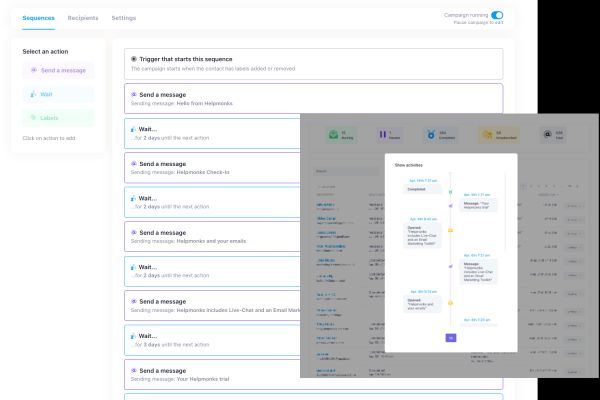
Introducing new pricing for Helpmonks
Discover Helpmonks' new pricing structure, featuring a flexible PRO plan, a FREE plan for smaller teams, and an exciting affiliate program. Experience unparalleled email management solutions today!
Read nowHave you ever received a lightning-fast response from a customer service query and wondered how it was possible? Well, chances are, it was automated customer service.
Good customer service epitomizes your business's commitment to your customers. It's where your brand meets its consumers with solutions and experiences that shape perceptions. With automated customer service, you get a solution that understands your customer's needs and can respond to them 24/7.
Are you eager to learn more about automated customer service and how to implement it? This article will cover everything you need to know!
Automated customer service refers to using technology, such as artificial intelligence (AI), chatbots, and self-service tools, to respond to customers. The technology handles customer inquiries and issues without requiring direct human intervention.
Traditionally, customer service has been human-centric, relying on dedicated team members to address customers' needs. While this personalized touch remains invaluable, the evolving landscape requires you to embrace automated customer service to enhance your traditional approaches.
So, instead of relying on human agents, you integrate intelligent systems that can analyze, understand, and respond to customer queries with remarkable accuracy. With automation, you can provide improved customer support, leading to a better customer experience.
Automated customer service comes with many benefits for your business compared to traditional customer service. Let's look at the top advantages of automating customer service:
Automation is synonymous with efficiency and is a game-changer for businesses in terms of customer service.
Traditional customer service models often struggle with time and resource limitations, leading to delays and a potential backlog of inquiries. On the other hand, automated customer service systems handle routine inquiries instantly. They can provide product information, order status updates, and answer FAQs 24/7.
But the efficiency of automated customer service doesn't just lie in speed. It extends to the ability to multitask on a grand scale. Think of this: your human agents can only handle one query at a time. Automated systems can engage with multiple customers simultaneously. Now, you can give your customers real-time support without compromising the quality of their responses.
This efficiency is a blessing during peak times when the influx of inquiries is high. Automated systems manage the surge seamlessly so that each customer gets the attention they deserve. This meets customer expectations and contributes to a positive perception of your brand's responsiveness.
Since automated customer service systems can multitask, they're a great asset for cost savings. Traditional customer service models include hefty expenses, like a large workforce, equipment, and training.
Automated systems, on the other hand, operate constantly without the need for breaks, holidays, or overtime pay. They handle routine tasks at a fraction of the cost of maintaining a human support team.
When processes are streamlined and manual intervention is minimized, human resources can be reallocated to focus on more complex and value-driven tasks. This enhances workforce productivity and ensures agents spend time on tasks that need a personal touch.
As a business, maintaining consistency is critical to building a strong and trustworthy brand reputation. Automated service ensures every customer interaction adheres to predefined standards, regardless of the time, day, or channel.
Your automated customer service systems will follow established protocols and guidelines to ensure consistent support. Your customers can reach out through live chat, email response, or even social media to get the same solutions. The consistency extends to the tone of communication and the accuracy of the information provided.
Your business will reap better customer satisfaction as a result. This is because each interaction reflects consistent professionalism and attention.
Automated customer service systems are scalable, making them perfect for your business's evolving needs.
Traditional customer service setups require increased staff and resources to handle more customers. On the other hand, automated systems like AI chatbots and self-service portals can manage more queries without additional human resources.
Your customer base expands with your business growth. An AI chatbot will handle thousands of interactions simultaneously, something impossible for a team of human agents. This scalability ensures the quality of your service remains consistent as your customer base grows.
You can easily update these systems to improve them with new features to meet evolving customer needs and business goals.
Automated systems adapt quickly to market changes or customer feedback without the need for extensive training or hiring.
Automated customer service is a game-changer for your business, especially for data-driven insights. When you implement this technology, you'll gather a wealth of data about your customers' behaviors, preferences, and pain points.
For instance, consider integrating a chatbot into your customer service system. It does more than answer queries; it also collects data on the types of questions asked, the frequency of specific issues, and even customer sentiment.
This information is gold for your business. You can analyze it to identify trends, anticipate customer needs, and tailor your services accordingly.
Let's say your data shows a high volume of queries about a product feature. You can then focus your resources on improving that feature or providing more detailed information on your website.
Collecting this data will also help when you want to personalize customer interactions. The system can offer relevant recommendations and solutions based on previous interactions, enhancing customer engagement.

As we have seen, automated customer service offers a spectrum of benefits. But like any transformative technology, it comes with its challenges.
Addressing these concerns is crucial to effectively integrating automated systems into your customer service strategy.
Here are the main drawbacks and how you can mitigate them:
The greatest strength of human customer service over automated systems is the ability to infuse a personal touch into interactions.
Human agents bring empathy, intuition, and a nuanced understanding beyond predefined algorithms. Their warmth and emotional intelligence create a unique connection with customers to foster trust and loyalty.
In contrast, automated customer service, while efficient and precise, may lack the finesse of human interactions. The automated systems operate within the boundaries of programmed responses. As such, they may miss the emotional context that human agents can easily navigate.
This is a huge drawback, considering that 80% of customers want to speak to a human customer service agent.
You can use one of the most effective automation strategies to address this concern: Natural Language Processing. NLP uses artificial intelligence to understand and respond to customer queries in natural human language. It allows systems to recognize intent, analyze sentiment, and provide contextually relevant information.
Integrating NLP into your system will ensure that automated responses mirror the natural cadence of human conversation for a better personal touch.
Automated systems can only solve what they're programmed to handle.
While they excel at addressing routine inquiries and following predefined protocols, their problem-solving capabilities are limited to the scope of their programming. Unlike human agents with critical thinking skills and adaptability, automated systems may struggle with complex or unique issues.
To curb this limitation, you can implement a tiered approach to customer service. Automated systems can handle routine queries and straightforward issues for quick and accurate responses. For the more difficult situations, assign a human agent to the task.
You should consistently monitor and update your automated systems' programming based on customer interactions and feedback. This will contribute to an adaptive problem-solving capability as the system evolves.
If you've interacted with a chatbot, you know the feeling when it repeatedly gives the same answer. Other times, it fails to understand your queries.
You must address the limitations of your automated systems to ensure a positive customer experience. Here are some strategies you can implement:
Here are five examples of how you can use automated customer service to enhance efficiency, responsiveness, and overall customer satisfaction:
A chatbot is a virtual assistant on your website that uses AI to interact with visitors. It can answer questions, guide customers through your site, and even assist with transactions.
The best thing about chatbots is that they are always on duty late at night or early in the morning. So, you can offer round-the-clock service without having staff on duty 24/7.
Chatbots are fantastic at handling routine inquiries. Questions that pop up frequently? Your chatbot can easily handle them, freeing your human team to tackle more complex issues. They speed up your response times with quick answers that customers can implement.
A chatbot on your website will also help you gather data. Every interaction helps you better understand your customers–what they're looking for, common issues they face, and how they navigate your site. This insight is invaluable for tailoring your services and improving the customer experience.
Automated email responses are pre-set replies sent to customers when they contact your business via email. These triggered emails follow specific actions or inquiries to ensure your customers receive immediate acknowledgment of their communication.
Automating your emails provides instant communication. When customers send an email, you instantly let them know you've received their message and are attending to it. This quick acknowledgment will enhance customer satisfaction and trust in your business.
They're also great for managing expectations. Use them to inform customers about response times, direct them to FAQs, or provide helpful links while they wait for a detailed response. This will help you manage high email volumes, especially during peak times or outside business hours.
You can also personalize these automated responses. Even though they're automated, you can tailor them to feel personal and relevant to the customer's inquiry. It's a personal touch that can positively impact how customers perceive your brand and its commitment to customer service.

An Interactive Voice Response (IVR) system is an automated telephony technology interacting with callers to gather information and route calls to different agents or departments.
When a customer calls your business, the IVR system is the first point of contact. It uses pre-recorded messages and menus to guide callers through options, like pressing different numbers to reach certain departments.
IVR systems reduce the need for human interaction on every call by directing callers to the right departments. This means you'll enjoy faster resolutions without involving more human agents.
IVR systems are also available 24/7. They provide consistent customer support, even outside of regular business hours. This is especially useful for providing basic information like business hours, location, or updates on ongoing issues.
You can also integrate your IVR systems with your CRM software to provide personalized experiences to callers. A good IVR system will recognize repeat customers, tailor messages based on their history, and predict why they're calling.
In modern business, social media engagement is crucial for effective communication and customer interaction. Chatbots on social media will help you foster a dynamic and accessible online presence.
They maintain a consistently responsive online persona to handle common queries, provide information, and guide users through basic troubleshooting. If you're in a service-oriented business, you can even use social media chatbots for appointment scheduling.
Automated ticketing systems streamline your customer support when managing inquiries, support requests, and service tickets.
When a support request comes in, the automated ticketing system uses smart pre-recorded messages and menus to guide users through options. It'll handle common queries to reduce the need for direct human interaction, leading to faster resolutions and more efficient support processes.
Unlike humans, these systems operate beyond regular hours with consistent support. Even better, you can integrate your automated ticketing system with CRM software. It'll then recognize patterns, track trends, and offer insights for continuous improvement.
To ensure the seamless integration of automated customer service, here are our top six strategies:
Your business can enhance customer interactions by implementing AI-driven chatbots, which provide instant support for common queries.
Ensure you train your chatbots to understand and respond to diverse customer inquiries. Regularly update the chatbot's knowledge base to stay current and provide accurate information.
Predefined response templates can ensure consistency and efficiency in customer interactions.
So, develop a template library covering various scenarios, such as common inquiries, issue resolutions, and follow-up communications. This approach saves time and guarantees that your team delivers professional, uniform responses.
You can customize the templates for a personalized touch. You should also regularly review and update them to align with your evolving customer base and industry trends.
You can reap more benefits from your customer service automation by syncing it with your CRM.
This integration provides a centralized view of customer interactions and history, enabling your team to deliver more personalized and informed support. Ensure the automation system captures and updates customer data in real time to prevent inconsistencies between automated and manual records.
This strategy will give your team a full understanding of each customer. It'll also foster stronger relationships and improve the overall efficiency of your support processes.

You can create a knowledge base to grant customers access to a repository of information where they can find answers.
Populate the knowledge base with frequently asked questions, troubleshooting guides, and informative articles. Organize the content intuitively to make it easy for customers to navigate and locate relevant information.
Update the knowledge base regularly to reflect changes in products, services, or customer inquiries. This approach reduces the workload on your support teams and empowers customers to resolve their issues independently.
You want to gather customer feedback, so encourage your customers to participate in surveys that explore their experiences with your products or services. Use the insights gathered to identify areas for improvement and constantly refine your customer service automation strategy.
Ensure that surveys are concise, relevant, and timed to capture valuable feedback. By involving customers in the improvement process, you show a commitment to providing top-notch service.
Integrating automation with human support strikes the perfect balance. While automation handles routine inquiries and tasks, human support steps in for complex issues and personalized assistance.
Establish transparent escalation processes for a smooth transition from automation to human support. Train your team to collaborate effectively with automation tools for a consistent customer service approach.
Automated customer service revolutionizes the way businesses interact with their customers. With automation, you'll enjoy increased efficiency, cost savings, a consistent customer experience, scalability, and data-driven insights.
If you don't know where to start, let Helpmonks do all the hard work! Our all-in-one customer engagement platform will help you build strong customer relationships. Complete with email marketing automation, a live chat widget, email CRM, and much more, you'll be ready to take on the world of automated customer service.
Take advantage of our free trial today!

Discover Helpmonks' new pricing structure, featuring a flexible PRO plan, a FREE plan for smaller teams, and an exciting affiliate program. Experience unparalleled email management solutions today!
Read now
Dynamic email signatures increase brand visibility, build brand identity, and boost conversions. Learn how to create and update dynamic email signatures.
Read now
Looking for an email marketing automation software? This guide shows what to look for. We'll also review the best tools for your online marketing needs.
Read now
Using customer engagement solutions helps you keep your existing customer base and grow. Here are the top 10 customer engagement solutions for your business.
Read now
Empower your team and delight your customers.
